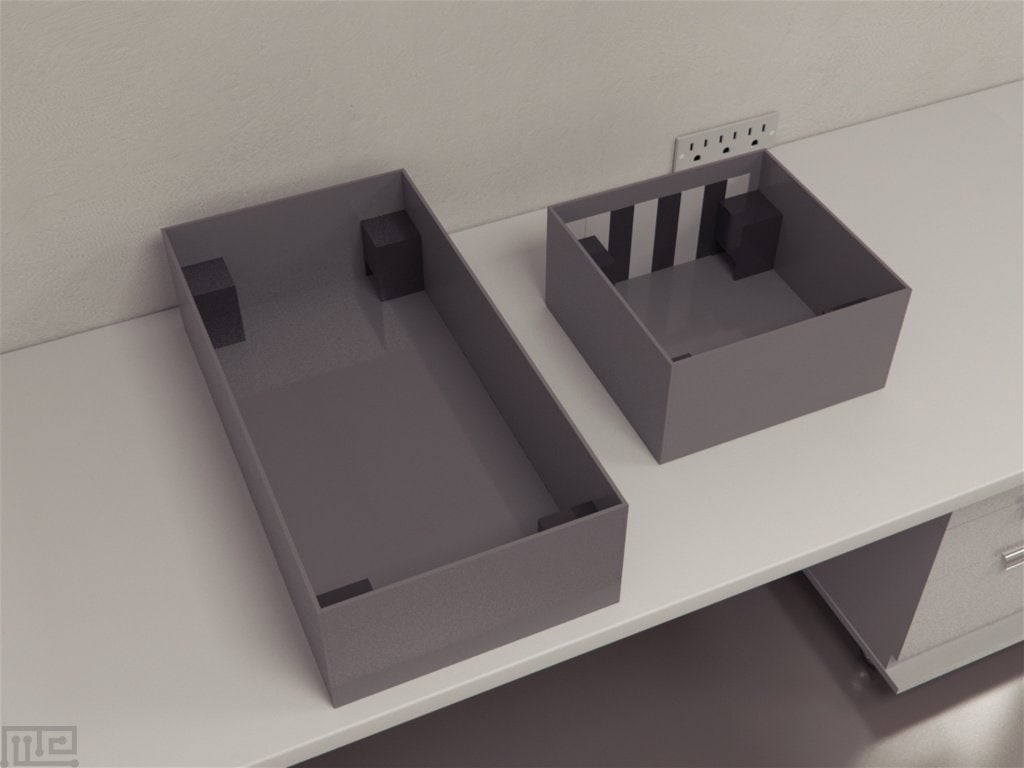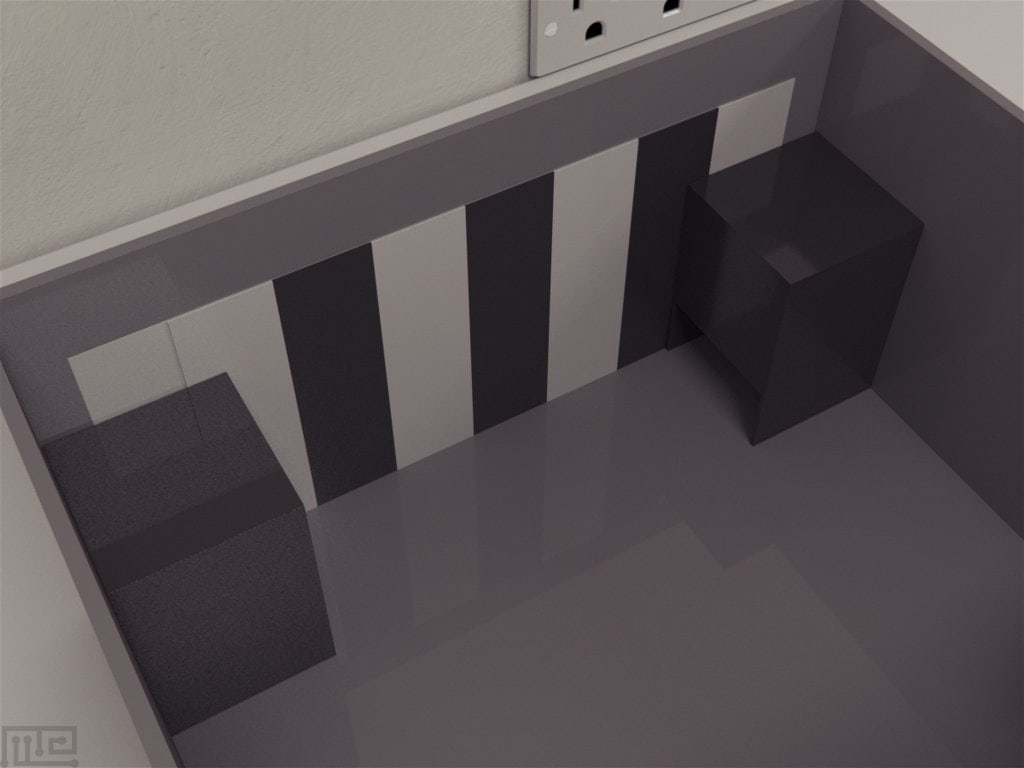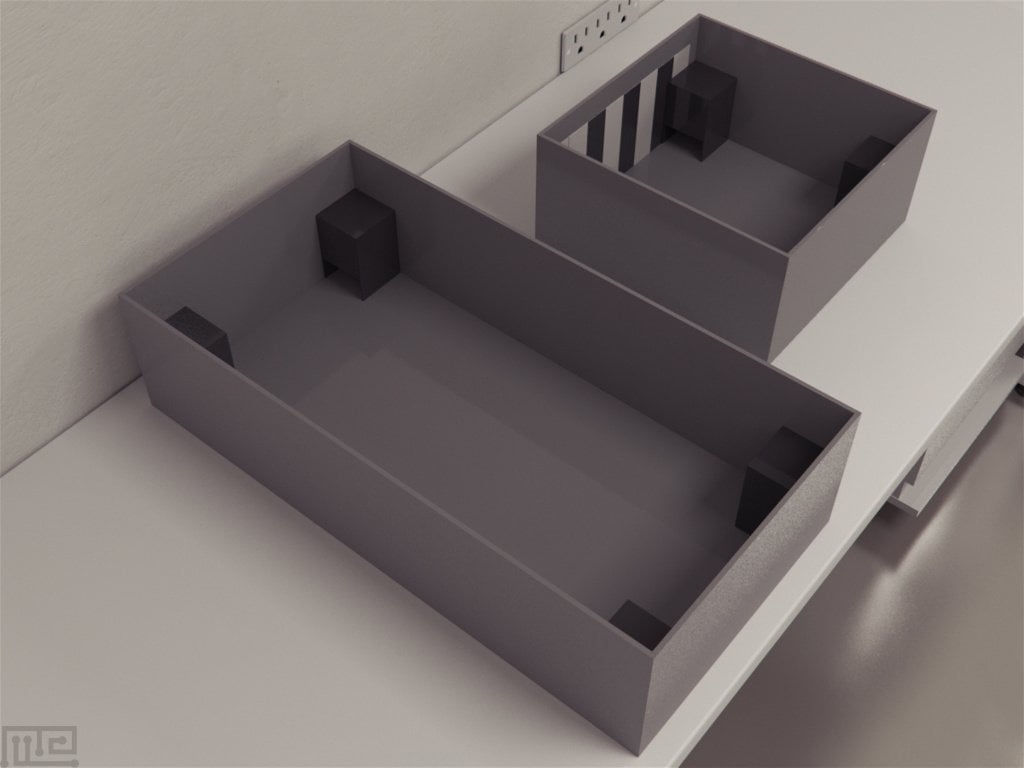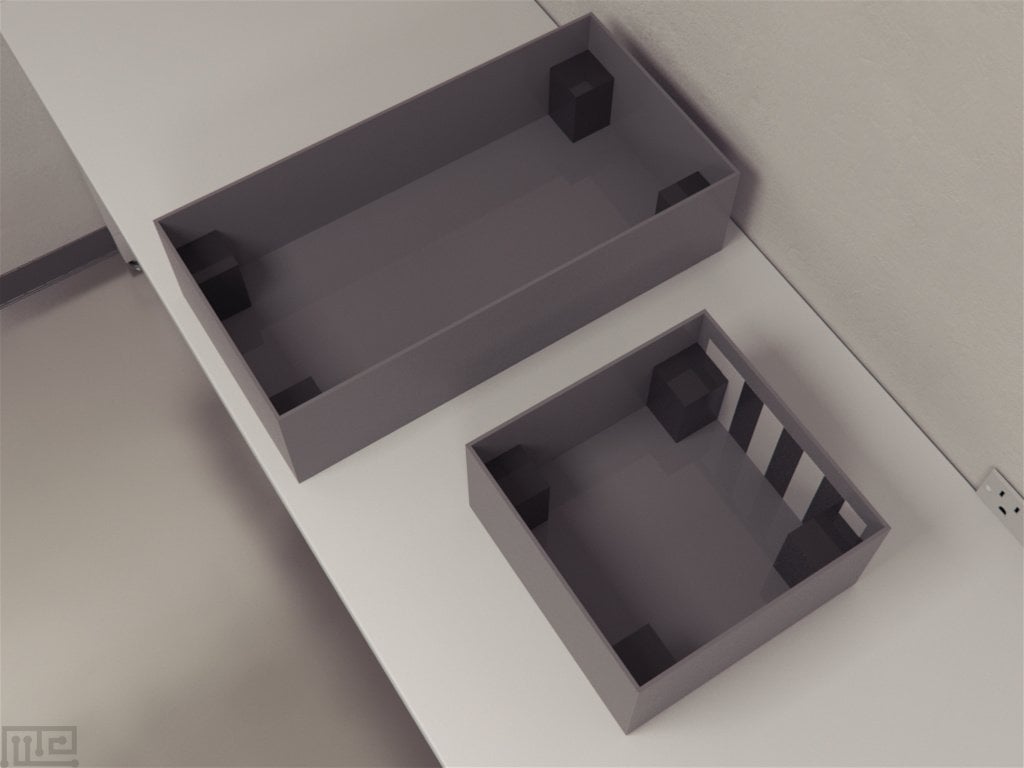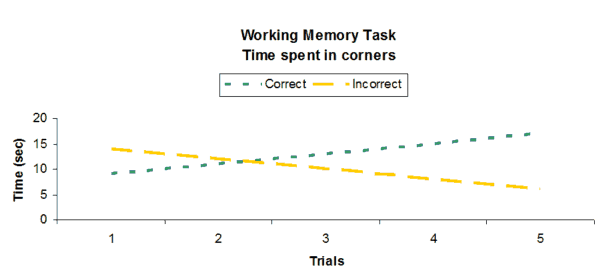Description
The Spatial Reorientation task was originally described in the literature in rodents by Lee et al (2015). The apparatus allows for tests of cue specificity and task specificity in spatial reorientation in mice using two types of
environmental cues: 1) boundaries and 2) features (stripes), in two types of tasks: A) working memory and B) reference memory.
The MazeEngineers apparatus comes with two chambers.
Chamber 1: A uniformly colored gray rectangular arena
Chamber 2: A square arena with three gray walls and one striped black/white, featurally distinctive wall
The arena is filled by the experimenter with 5 mm of water.
In each corner is a black box with opening (7.5 7.5 4 cm) on one side. To minimize the availability of any potential visual cues, the opening is always on the side of the box that faced away from the center of the arena.
Price & Dimensions
Mouse
$ 1490
Per Month- Chamber 1: Uniformly colored gray rectangular arena (40 cm x 80cm x 20 cm)
- Chamber 2: Square arena (40cm x 40cm x 20 cm) with three gray walls and one striped black/white, distinctive wall (stripe width, 4.5 cm)
- Black box (8cm x 8cm x 12 cm) in each corner, one of which has an opening (7.5cm x 7.5cm x 4 cm) on one side. The opening is always on the side of the box that faced away from the center of the arena.
Rat
$ 1590
Per Month- Chamber 1: Uniformly colored gray rectangular arena (60 cm x 120cm x 30 cm)
- Chamber 2: Square arena (60cm x 60cm x 30 cm) with three gray walls and one striped black/white, distinctive wall (stripe width, 6.75 cm)
- Black box (12 cm x 12 cm x 18 cm) in each corner, one of which has an opening (11.25cm x 11.25cm x 6cm) on one side. The opening is always on the side of the box that faced away from the center of the arena.
Documentation
Introduction
Spatial navigation and memory play an important role in the survival and functioning of any navigating species. The most common model in the investigation of spatial cognition makes use of rodents in a variety of spatially motivated tasks. However, the traditional methods of investigation such as the Morris Water Maze fail to provide an insight into the specificity of the processes underlying navigation.
Lee and colleagues addressed the two factors, the environmental cues and the task involved in learning them, that influence spatial navigation in their findings published in 2015. They developed the Spatial Reorientation task to test cue specificity and task specificity in spatial reorientation.
The apparatus consists of two different and separate chambers to test task and cue specificity in the spatial reorientation of mice. The square box, unlike the rectangle box, has three gray walls and one wall striped black and white. These arenas use two types of cues, boundaries, and features, for two types of tasks, working memory task and reference memory task.
Apparatus and Equipment
The apparatus consists of two separate boxes: A rectangle box with uniformly colored gray walls having dimensions 20 x 80 x 20 cm and a square box having dimensions 40 x 40 x 20 cm with three uniformly colored gray walls and one featured wall having black and white stripes. At the corner of each of these boxes are four black boxes (8 x8 x 12 cm), with one of the boxes having an opening of 7.5 x 7.5 x 4 cm on one side facing away from the central arena to avoid, any potential, visual cue.
Training Protocol
The experiments are carried out in a testing area created using uniformly colored and light-proof black curtains. The sessions are monitored and recorded using tracking software and video recorder, such as Noldus Ethovision XT, mounted on the ceiling. The arenas are filled with 5 mm of water, such that only the paws of the animal get wet. The water and the bright light of the open arena motivate the subject to explore and find the corner box with the opening. The target corner box provides the subject with a safe and dry space.
The subject is carried from its home cage to the test arena in a covered cylinder (10 x 15 cm) and is introduced to the center of the arena. For each experiment, the subject is first introduced into the arena and allowed to explore the area until it takes shelter in the target location. The subject is then removed, disoriented and reintroduced into the arena. For working memory task, the position of the target corner box is varied across trials. During the test phase, the target box opening is blocked off, and the subject is immediately returned to the arena. For the reference memory task, the target box remains accessible and constant throughout trials. The subject is recorded for 60 seconds after being released, and its navigation is analyzed. (Lee et al., 2015)
Before reintroduction into the arena, the subject is disoriented in the covered cylinder for 30 seconds during which the arena is rotated 90 degrees with respect to the environment and the experimenter and the target box is rinsed with water. Each test session lasts about 1 minute after reintroduction, and the inter-trial interval is maintained at about 1 hour. (Lee et al., 2015)
Evaluation of spatial working memory using boundary geometry within a rectangular arena
The target corner box is changed for each trial and is made inaccessible during the 60 second test period to measure time spent by the subject at each corner. The subject will be likely to prefer geometrically correct corners in the reorientation task on the successful use of geometry.
Evaluation of working memory using a distinctive feature wall of a square arena
Subjects are tested in the square arena that lacked environmental geometry. The striped wall provides the subject with distinction in comparison to the other walls. When the subject successfully utilizes the feature wall as the positioning cue in the reorientation task, it chooses the correct target corner. Partial utilization of the position cue results in the preference for the striped corner boxes when the target is a striped corner and the two plain corners when the target is a plain corner.
Evaluation of the effects of reinforcement training on reference memory using boundary geometry
The experiment is carried similarly as mentioned earlier with two exceptions: goal location remained constant during all trials, and target corner remained accessible after the disorientation procedure.
Evaluation of the effects of stable goal location and reinforcement on reference memory using a distinctive feature wall
The experiment is carried out as mentioned above in a square arena with feature wall. Stable goal and reinforcement training is used to assess the reference memory. The feature wall is expected to improve the performance of the reference task when the target location is near the striped wall.
Sample Data
The data collected through the Spatial Reorientation task consists of:
- The first approaches and the total time spent in each corner during the spontaneous navigation task
- The first approaches and total time spent in the incorrect three corners before reaching the target corner in the reference memory task.
When the subject is within 3 cm from the corner box, it is regarded as the corner choice.
Strengths & Limitations
The Spatial Reorientation task, unlike traditional methods of behavioral testing such as the Morris Water Test, allows an insight into the specificity of the processes underlying spatial navigation. The two set-ups allow investigation of boundary geometry and feature wall’s influence on the spatial working memory mapping. The test assists in the investigation of spatial impairment and memory in genetic disorders (Lee et al., 2017).
Summary and Key Points
- The Spatial Reorientation task uses two separate boxes: rectangle box with uniformly colored walls and a square box with 3 uniformly colored box and a feature wall (black and white stripes)
- Unlike traditional methods of behavioral testing, the Spatial Reorientation task allows an insight into the specificity of the processes underlying navigation.
- The rectangle box assists in with investigating the geometric influence on spatial and reference working memory.
- The square box allows the subject to base its preference on the visual cue provided by the feature wall during the reorientation task
- The water in the arena and the bright light motivate the subject to seek shelter in the corner boxes
- The target corner box entry is kept facing away from the central arena to avoid visual cue
References
Lee SA, Tucci V, Sovrano VA, Vallortigara G. Working memory and reference memory tests of spatial navigation in mice (Mus musculus). J Comp Psychol. 2015 May;129(2):189-97. doi: 10.1037/a0039129.
Lee SA, Tucci V, Vallortigara G. Spatial Impairment and Memory in Genetic Disorders: Insights from Mouse Models. Brain Sci. 2017 Feb 9;7(2). pii: E17. doi: 10.3390/brainsci7020017.

